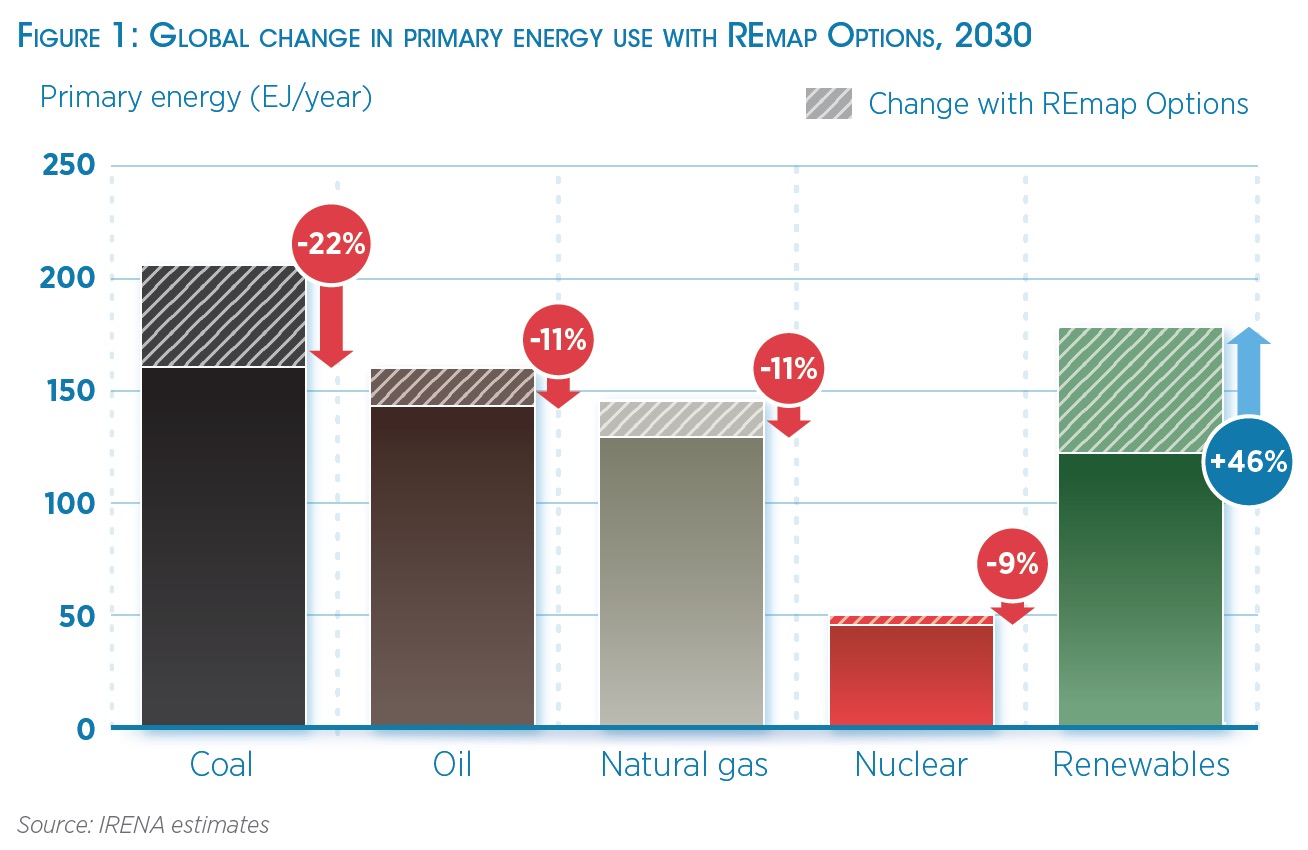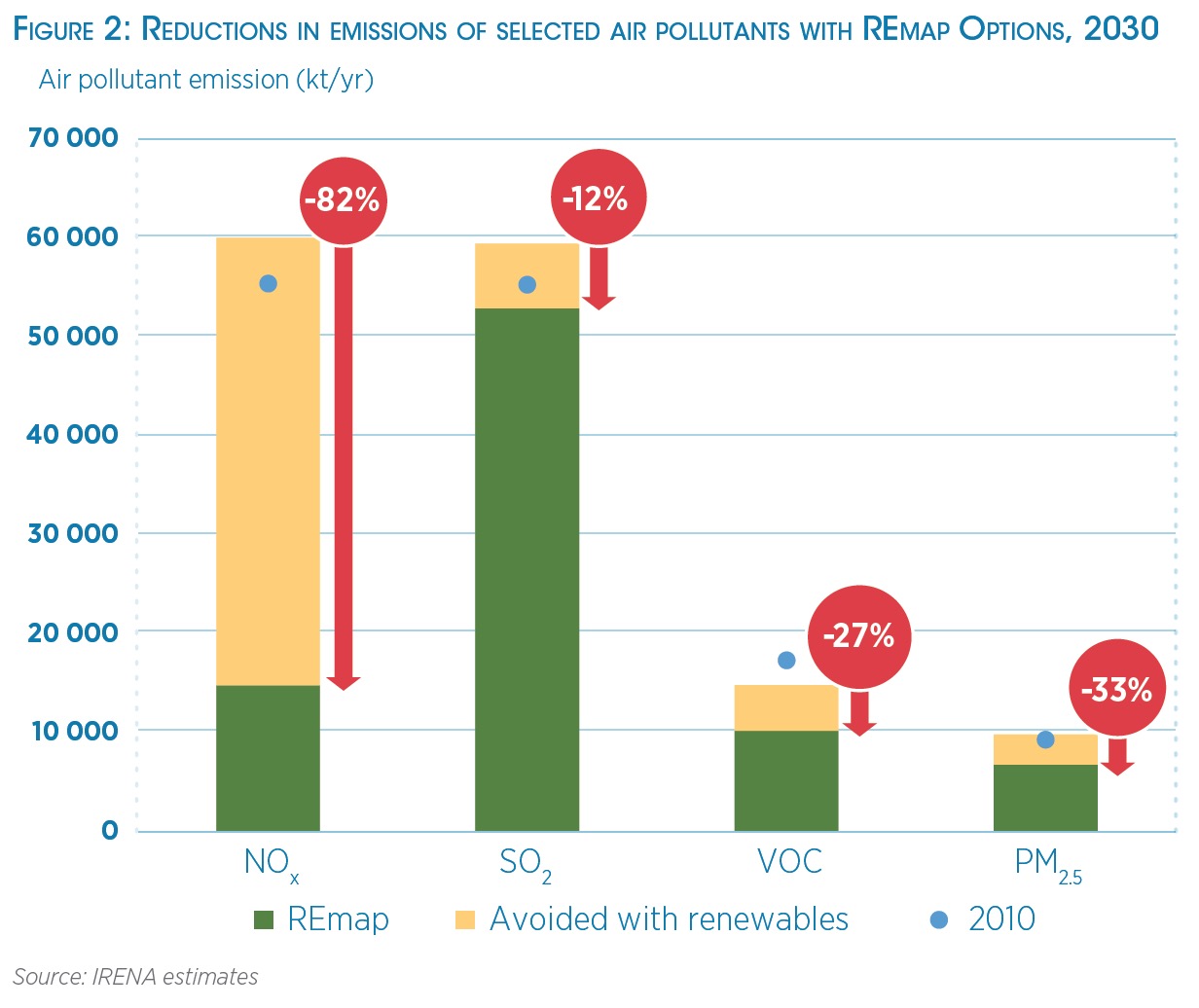INTERNATIONAL RENEWABLE ENERGY AGENCY (IRENA)
The True Cost of Fossil Fuels: Saving on the Externalities of Air Pollution and Climate Change
This brief quantifies air pollution and climate change externalities related to fossil fuels and the extent these can be reduced with higher uptake of renewables. For this purpose, the analysis compares global energy demand between now and 2030 through two cases: first, based on current and planned energy policies; and second, by doubling the share of renewables in the energy mix within 15 years.
The reduction of pollution and climate impact through rapidly increased use of renewable energy by 2030 could save up to USD 4.2 trillion per year worldwide, 15 times the associated costs of doubling the share of renewables. Today’s energy markets, however, do not adequately value climate impact or air pollution. Energy and environmental policies need to correct for these externalities.
Key Findings
- External costs related to the use of fossil fuels stem from many causes. These include pollution and environmental degradation resulting from the extraction of resources; indoor and outdoor air pollution due directly to fuel combustion as well as non-combustion emissions such as those from industrial processes; and the negative impact of extreme weather events caused by global warming.
- Doubling the renewable share in the global energy mix can result in significant savings of fossil fuels. Compared to the 2030 Reference Case, coal, oil and natural gas supplies can be reduced by 22%, 11% and 11%, respectively, while primary renewable energy supply could increase by up to 46% over the coming 15 years.
- Modern renewables include multiple types of sustainable, cost-effective bioenergy and biofuels, which comprise crucial elements in the energy transition. The envisaged scale-up of modern renewables also allows for the phase-out of traditional bioenergy uses that involve unsustainable fuel gathering and toxic combustion.
- Reduced use of fossil fuels allows the avoidance of carbon dioxide (CO2) emissions and air pollutants. With the renewable share doubled, particulate matter (PM2.5) emissions that result in serious adverse effects on human health would be reduced by 33% compared to today’s levels. Likewise, emissions of mono-nitrogen oxides (NOx), sulphur dioxide (SO2), ammonia (NH3) and volatile organic compounds (VOCs), all of which have serious health effects, would also be lower than today’s levels. Doubling the share of renewables, combined with significant increases in energy efficiency, would halve energy-related CO2 emissions in 2030, in comparison to current and planned energy policies.
- These substitutions would reduce externalities by at least USD 1.2 trillion per year and as much as USD 4.2 trillion per year by 2030, in comparison to current policies. Much of this reduction relates to indoor and outdoor air pollution.
- Doubling renewables in the global energy mix could save up to 4 million lives annually by 2030. This compares with 3.7 million premature deaths from ambient air pollution and 4.3 million deaths from household air pollution in 2012, according to World Health Organization (WHO) figures.
Introduction
This brief quantifies air pollution and climate change externalities related to the combustion of fossil fuels and bioenergy around the world. The assessment is part of a broader analysis undertaken by the International Renewable Energy Agency (IRENA) to lay out a roadmap to double the share of renewables in the global energy mix by 2030. IRENA’s REmap analysis spans 40 countries that account for 80% of total global energy demand.1
The analysis, carried out in consultation with experts from each country, looks at the developments in global energy demand between now and 2030 for two cases. The first is the Reference Case, which focuses on renewable energy deployment according to today’s country plans and current and planned energy policies. The second case identifies renewable energy technology options that could double the renewable energy share in the global energy mix by 2030.
Emissions of air pollutants and CO2 emissions are quantified for the 2010-2030 period, and their cost to human health, agricultural crops and the environment is assessed. This has been done based on a range of carbon prices for the world as a whole, and on the damage costs of pollutants differentiated by country and sector.
With renewables doubled in the energy mix, the resulting reduction of air pollution, both indoors and outdoors, would offer large financial savings estimated to be between USD 1 trillion and USD 3.2 trillion per year in 2030, compared to the Reference Case (i.e. business as usual). Annual savings related to climate change could amount to between USD 200 billion and USD 1 trillion depending on how carbon emissions are priced. In total, these savings are at least four times—and as much as fifteen times—higher than the costs associated with doubling the share of renewables in the global energy mix by 2030.
These tremendous savings, however, will not occur without policy change. Energy markets generally do not adequately value or account for externalities related to climate change and air pollution (Parry et al., 2014). Energy and environment policies, therefore, must be re-designed to correct for these externalities.
Pollution and Climate Effects due to Fuel Combustion
The combustion of fossil fuels and traditional uses of bioenergy is a major source of local air pollution. SO2, NOx and PM2.5 are some of the main pollutants. These pollutants can cause adverse human health effects, but they can also cause reduced agricultural yields, damage to forests and fisheries (acid rain), and damage to buildings and infrastructure. The majority of adverse impacts, however, are found to be on human health. Worldwide, some 8 million people per year die prematurely from indoor and outdoor air pollution caused by energy consumption for heating, cooking, power generation and transport.
Currently, the external effects of energy supply and use related to climate change and air pollution are in the order of USD 2.2 trillion – USD 5.9 trillion per year. In comparison, the cost of global energy supply is in the order of USD 5 trillion per year.2 According to European Commission estimates, the external costs of air pollution in the European Union (EU) alone ranged between USD 330 billion and USD 940 billion in 2010 (Verheye, 2014).
Different pollutants arise from different energy uses. The residential sector (classed as part of buildings within the REmap methodology), for example, is responsible for substantial PM and VOC emissions. In contrast, NOx emissions originate mainly from the transport sector and SO2 emissions mainly from power generation. The sector breakdown of total externalities also differs by region. In Africa, the main sector responsible for pollution is the residential sector, whereas in most other regions, power generation and transport are the main contributors. For instance in several Southeast Asian countries, urban transport is a major contributor to air pollution. In member countries of the Organisation for Economic Co-operation and Development (OECD) a significant share of the externalities associated with outdoor air pollution come from road transport. In China, coal-based power generation and heating are the major contributors.
This brief quantifies the air pollution and climate change effects of energy use on human health, agricultural crops and the environment. Human health effects present in the form of premature disease and death (i.e. morbidity and mortality) that account for well over 90% of all external costs. Other costs arise through impacts on agriculture, costs to materials and impacts on habitats and ecosystems. Climate change impacts are also important, but their valuation is more uncertain than that of local air pollutants. Other external effects exist (e.g. noise pollution from combustion engines, which is reduced once electric vehicles are introduced); however, such effects are excluded in this study.
Coal-based processes have the highest and most adverse external effects, followed by oil. External effects are typically lowest for renewables and nuclear power. Among renewables, however, bioenergy is an exception, with pollution and climate impacts between those of fossil fuels and other renewables. External effects are especially high in the case of indoor air pollution from traditional bioenergy uses, since traditional cooking and heating typically involve minimal or no emissions control. The scale-up of renewables also involves replacing traditional bioenergy with more sustainable forms.
There is a need to understand the change in external costs that can be achieved through increased use of modern renewables, in comparison to fossil fuels and traditional uses of bioenergy. This is particularly important for the cost-benefit analyses of different technologies, since consideration of external effects can change the ranking order of investments and the net cost or savings of each technology option.
Download full version (PDF): The True Cost of Fossil Fuels
About the International Renewable Energy Agency (IRENA)
www.irena.org
The International Renewable Energy Agency (IRENA) is an intergovernmental organisation that supports countries in their transition to a sustainable energy future, and serves as the principal platform for international co-operation, a centre of excellence, and a repository of policy, technology, resource and financial knowledge on renewable energy. IRENA promotes the widespread adoption and sustainable use of all forms of renewable energy, including bioenergy, geothermal, hydropower, ocean, solar and wind energy, in the pursuit of sustainable development, energy access, energy security and low-carbon economic growth and prosperity.
Tags: Fossil Fuels, International Renewable Energy Agency, IRENA, REmap, Renewables








 RSS Feed
RSS Feed